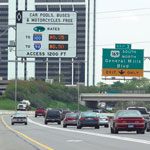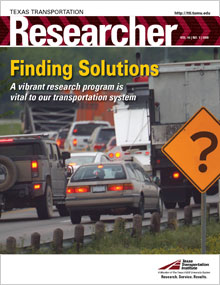How do we maximize the transportation system we already have?
Through research.

For over 20 years, through support from the Texas Department of Transportation (TxDOT), multiple states and metropolitan planning organizations, the American Road and Transportation Builders Association and the U.S. Department of Transportation University Transportation Centers Program, the Texas Transportation Institute (TTI) has helped battle the traffic congestion problem by tracking and developing mobility data for major urban areas across the nation. Recent expansion of the study to include all 437 urban areas and an improved methodology have broadened the scope of the work to include recommended strategies for agencies, businesses and commuters to help implement solutions to the congestion problem. Since the 1970s, when it became clear that a single solution of building more roads would not keep pace with the congestion problem, TTI/TxDOT cooperative research has produced advances in freeway operations; lane management; signal timing; intersection, sign and roadway design; and public transportation that have all been implemented in Texas’ major urban areas.
Studying traffic’s big squeeze
Traffic congestion burns enough fuel every year to fill 58 supertankers and erodes enough time to consume 105 million weeks of vacation. Each one of us wastes nearly a week’s worth of time, 26 gallons of ever-more-costly fuel and a whopping $710 — all because of congestion.
TTI Research Engineer Tim Lomax and Associate Research Scientist David Schrank are at the forefront of identifying the mobility-busting characteristics that choke off traffic flow in cities across the country. Their research culminates in widely utilized reports on urban mobility, which identify solutions that maximize the efficiency of existing infrastructure and provide alternatives to combat the multi-headed problem.
A tool used nationwide
“Using the mobility data we gather has proven helpful to planning and transportation agencies in just about every part of the country,” says Lomax. “Reports indicate that our data and performance measures are used in efforts to communicate technical information to the general public in ways that non-technical audiences understand.”
The 2007 Urban Mobility Report contains a number of recommendations to address the mobility problem, including:
- providing more travel options — using the Internet to telecommute, value pricing toll lanes and encouraging increased use of transit;
- adding capacity — adding lanes, buses and new roadways, improving roadway designs, adding rail service, etc.;
- managing the demand — building more “car free” communities and adding more bike and pedestrian options; and
- increasing the efficiency of the system — maximizing timing of traffic signals, managing special events (e.g., sporting or music events), metering freeway ramp, etc.
